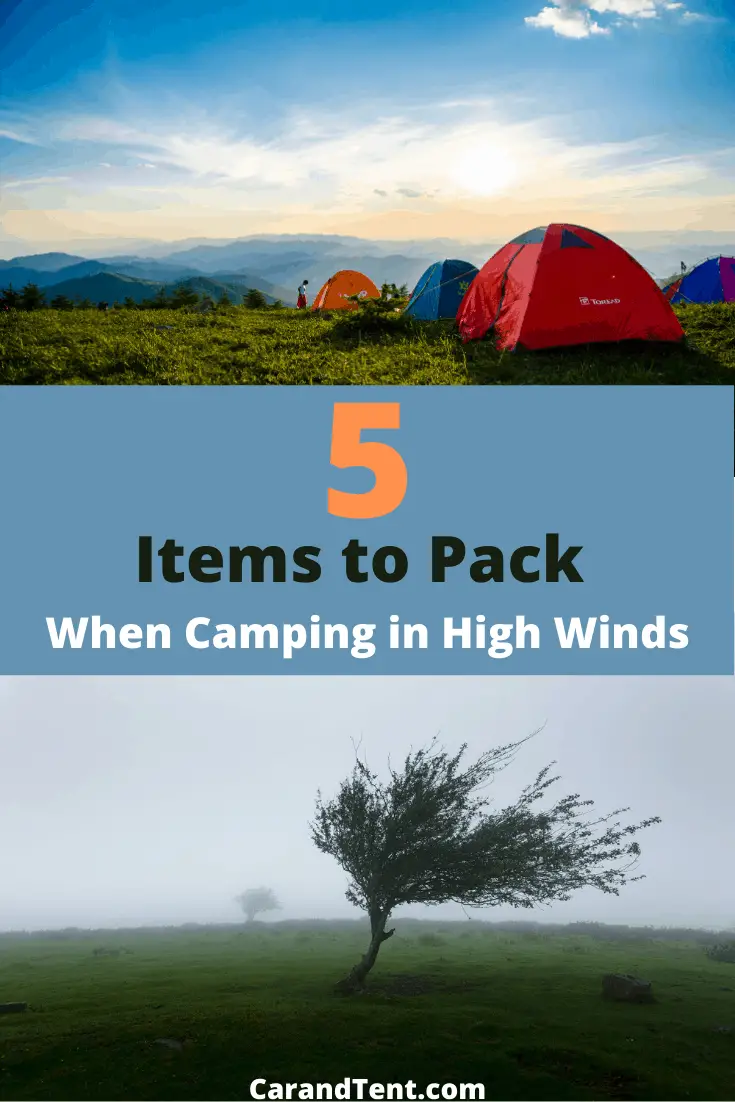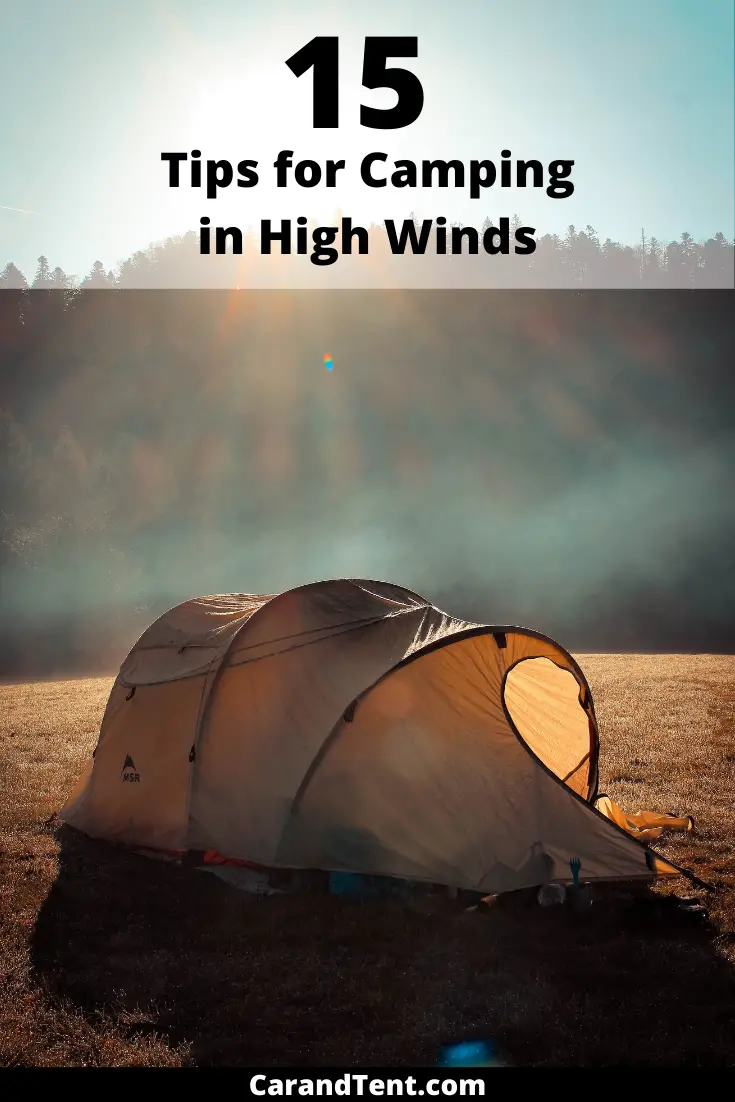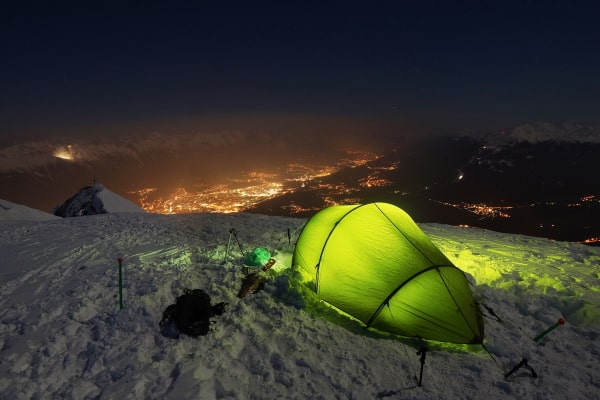
As campers, the weather doesn’t always conform to our travel plans. Sometimes it’s too hot, other times it’s raining, and sometimes it’s just too darn windy.
This doesn’t mean we have to cancel our camping trips though. Use these tips for camping in high winds and you’ll stay safe and have fun even when it’s windy.
Table of Contents
The Tent
One of the first thoughts that comes to mind when people think about camping in high winds is what to do about the tent. Getting and keeping a tent up in high winds can be tricky so here are a few tips to make things easier for you.
- Pack a smaller tent.
- Set up your tent to work with the wind.
- Pack stakes, sandbags, and guy lines.
- Leave the rain fly in your backpack.
- Consider skipping the tent.
Pack a Smaller Tent
Tall tents take a beating in high winds. Low-lowing tents, on the other hand, tend to hold up very well in high winds. The reason for this is that they don’t have as much surface area.
A small bivy tent or small dome tent will be much easier to set up and keep up when compared to a large cabin tent. You’ll also suffer much less wind noise in a smaller tent which will make getting a good night’s sleep that much easier.
Set Your Tent Up to Work With The Wind
Before setting up your tent, take a moment to determine which way the wind is blowing. Once you know which way the wind is blowing, you can set your tent up to work with it rather than against it.
For those of you with tunnel tents, set up the tent so that the most narrow part of the tent is facing the wind. This will reduce the amount of surface area that gets buffeted by the wind.
If you have a dome tent, consider setting the tent up so that the tent’s door is facing away from the wind. This will help keep sand, dirt, leaves, and any other things that might blow around your campsite out of your tent. It will also make mornings a little more pleasant as you won’t be hit in the face with the wind as soon as you leave your tent.
Use Stakes, Sand Bags, and Guy Lines
Like many of you, I’ve gone on quite a few pleasant camping trips where I didn’t even bother to stake out my tent. The wind was mild, my tent was small, and leaving a backpack in the tent easily kept it from blowing over.
On windy conditions, a set up like this isn’t going to cut it. Setting up camp is going to be a little more work but it will most certainly be worth it. Make sure you pack your stakes and guy lines and use more than you think you need to.
If you’re camping on the beach, in the desert, or in a place with soft soil, bury your stakes and fill up sandbags to drop on top of them. This will ensure that your stakes can’t work themselves loose while you sleep or head out on your day hikes.
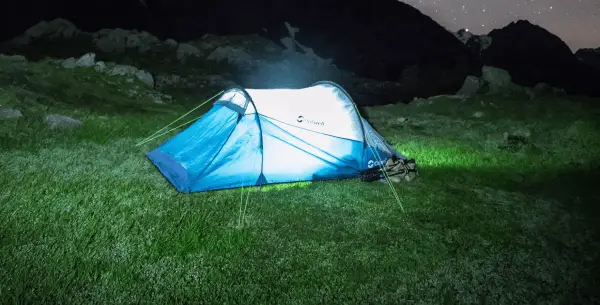
Forget The Rain Fly (Unless It’s Raining)
The rain fly is only going to make your tent a larger target for the wind. On top of this, it can trap wind inside of your tent and cause it to create lift inside of your tent.
On the other hand, high winds can often mean a high likelihood of rain. Be sure to check the forecast before you decide to go to sleep without your rain fly on. Even a small amount of rain in heavy winds will quickly soak the inside of your tent.
Skip The Tent Altogether
One substantial benefit of camping in high winds is that you won’t have to worry about mosquitos, flies, gnats, and any other swarms of insects flying around you. Being insect-free makes it much easier to go to sleep without a tent.
Assuming it isn’t going to rain, think about sleeping under the stars. Skipping the tent in favor of a night of cowboy camping will reduce wind noise and will give you one less thing to worry about. Aim your body with your head pointed into the wind and leave your backpack behind you to create a small shield for your face. This will help reduce your chances of waking up with windburn on your face. (more on that later)
Your Gear
For the most part, you’ll be packing the same gear you’d always bring on a camping trip. However, there are a few extra items you might want to consider.
These include:
- A jacket with a hood.
- A pair of goggles and a face mask.
- A shovel with a pickaxe.
- Food that doesn’t require a fire.
- Earplugs.
Pack a Jacket With a Hood
In the woods, a simple jacket, windbreaker, or sweatshirt with a hood can be used to help keep the wind out of your eyes and off of your face. This might seem like a simple tip but it can be easy to forget a jacket when you’re camping in the heat of the summer.
Also, remember that the wind can play a big role in how warm you feel. The reason for this is because the wind will blow warm air away from your body so you’ll lose body heat much quicker than normal. This is what they mean by wind chill. Here is a fun wind chill calculator provided by weather.gov that you can use to see just how much the wind affects how cold a person feels.
Interestingly enough, the wind will only create a wind chill when it is colder than 50 degrees Fahrenheit. If it is warm out, the wind may actually increase the amount of heat you experience. However, the additional wind will increase the rate at which your sweat evaporates so a strong breeze on a 90-degree day should still help cool you down.
Bring Goggles and a Dust Mask (Desert and Beach Campers)
Dust storms can wreak havoc on your eyes, your sinuses, and even your lungs. When camping or even hiking through the desert, you’ll want to bring along a good set of goggles as well as something to protect your face.
My recommendation would be to buy a bandana and keep it tied up around your neck so that you can quickly and easily pull it up around your face when necessary. As for the goggles, a good set of military desert goggles is your best bet but most desert goggles will work just fine. Just make sure they provide UV protection or you’ll end up with cataracts later on in life.
Pack a Shovel with a Pickaxe
One of my favorite tools in the world is the mighty pickaxe. It makes trenching and digging so much easier than a simple shovel. Get a good shovel with a pickaxe and you’ll be able to dig holes for your stakes a whole lot quicker.
You can also use the pickaxe in the event that you need to soften up the ground to load your sandbags up with. Just be careful not to do a lot of digging in sensitive areas and always keep “leave no trace” in mind.
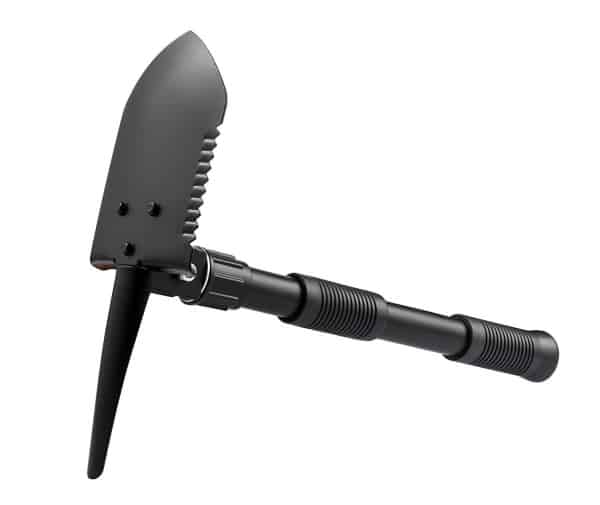
Consider Fireless Cooking Alternatives
Making a campfire or even using a gas stove can be difficult or even downright impossible in high winds. Not only this, but it might be illegal to start a campfire in your area.
Instead, pack food that you can eat cold or that you can easily cook up using a flameless heat kit. Prime examples of this are the heaters that come in the MRE kits and the Mountain House meals. However, you can buy these heaters and heat packs as stand-alone products on Amazon.
Think About Packing Ear Plugs
The wind noise inside of a tent at night can be deafening. Some people don’t mind falling asleep to it but personally, I find it stressful and almost impossible to fall asleep to.
You can get around this by bringing a set of earplugs with you. While the earplugs might not cut the noise out completely, it will reduce it down to a manageable level. With the earplugs in, the wind will become pleasant white noise for you to fall asleep to.
Other Tips For Camping In High Winds
Camping in high winds is challenging and there are a few other things you’ll want to keep in mind when doing so. Here are some additional considerations and tips to help you have a safer trip.
- Beware of windburn.
- Watch out for weak trees.
- Take advantage of the natural terrain.
- Create a wall.
- Bring a friend.
Beware of Wind Burn
Healthline.com defines windburn as, “a condition that refers to the burning and redness your skin might endure after spending time outdoors in the cold, windy air.” It is irritating and can even become painful. Also, it makes your face look ruddy.
Some people have said that windburn is just sunburn but I highly disagree. In fact, I’ve gotten windburn just from running at night in the winter.
For this reason, I always bring a few extra items with me when I go camping in windy areas. The first item I bring is lip balm so that the wind won’t chap my lips. The second item I bring is Vaseline and I’d suggest you bring some too. You can put this on your face to provide a protective layer against the wind. It works wonders and can be used to help cure dry skin and even chapped lips.
Watch Out for Weak Trees
If you’ve ever gone out to your favorite hiking trail the day after a bad storm, you know just how devastating heavy winds can be. If a tree falls in the woods and nobody is around to hear it, then nobody is around to get crushed by it either. However, if a tree falls in the woods when you’ve set up camp under it, you could be in for a tough time.
When possible, set your camp up away from trees during periods of high winds. If this isn’t possible, be sure to inspect all of the trees in the area that you’ll be camping in. Don’t put your tent in range of any trees that appear to be dead. These trees are much more likely to fall over under the stress of a heavy wind gust.
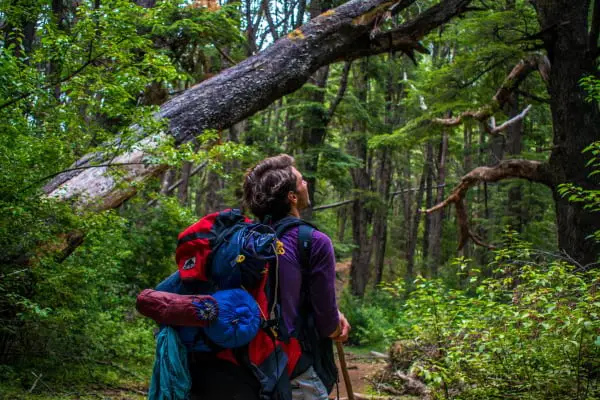
Take Advantage of The Natural Terrain
Sometimes a rock outcropping, hill, or ravine can provide a natural windbreak for you. However, there are some thoughts to keep in mind before setting up in these areas.
For starters, you’ll want to make sure to keep away from areas where rocks or tree branches could roll down onto you. On top of this, you’ll also want to make sure the area isn’t a low-lying area that is prone to flooding. Even if it isn’t supposed to rain in your area, a rainstorm many miles away could end up causing a flood in your area so you’ll want to stay away from flood areas at all costs.
Build a Wall
Sometimes you may have to create your own windbreak. In the desert or on the beach, sand will be plentiful so a nice sandbag wall might be worth creating. This is especially true if you plan on staying in the area for a prolonged period of time. Being in the wind can be tiring so the energy you invest in building your wall will be well worth it.
In other areas, you may be able to take advantage of large rocks, fallen tree branches, or even the trees themselves. Carefully set up a tarp in between two sturdy trees and you’ll have a small windbreak to hide behind.
Bring a Buddy
Setting up a tent, building walls, and watching out for dangerous situations is a lot easier when you have a friend to help you. I love solo hiking and camping but sometimes it really is much easier, safer, and even more fun to go with a group.
Final Thoughts
Camping in high winds is an experience all to itself and I’d highly recommend you give it a try. Spend a little extra time preparing for your trip and you’re sure to have a safe and fun experience.

